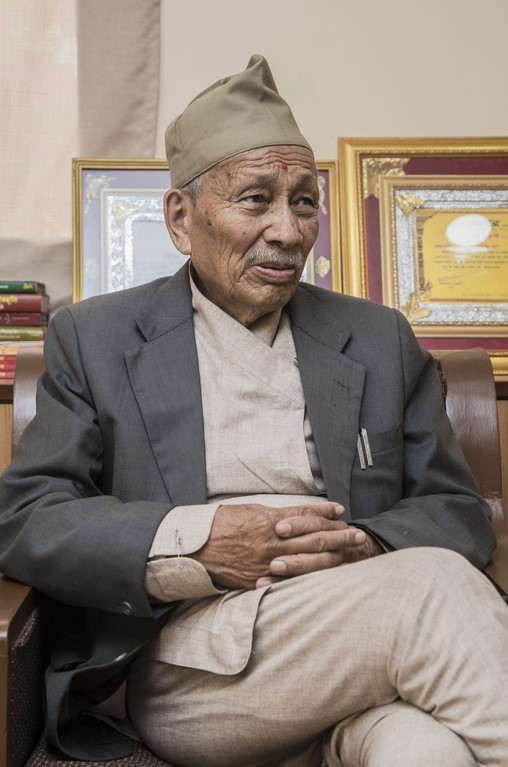
This is the 200th issue of the country’s leader in culture and lifestyle publications—ECS Nepal—a milestone in every sense of the word. It has taken eighteen long years to reach where it has today, but the journey has been a satisfying one, to say the least. Similarly, this is the 100th year in the life of the country’s leader in culture and heritage expertise—Satya Mohan Joshi—a momentous occasion, and his journey, too, has been a most satisfying one, and accomplished in every sense of the word.
So, what better way to take advantage of this fantastic conjunction of the stars than to have a feature of the luminary in this historical issue ECS Nepal?
My Surprise Visit
Thus, realizing the significance of this worthy endeavor, I paid a surprise visit to the centenarian’s home on a bright and sunny afternoon without so much as an appointment. I wanted to have a more candid awareness about the man, for enough has been written about him in books, magazines, dailies, and online portals, and as much has he been featured in numerous television shows. His is a familiar face, indeed!
One of the most recent news about him was his being presented with a vehicle by the Patan Municipality that came along with a driver and free maintenance and petrol for life. As I remember it, the mayor stated at the event that they had to now take into consideration his age, and it was the city’s responsibility to make his life more comfortable.
When I entered the entrance to his house in Bakhuwa Bahal, Patan, I found him with a mask around his mouth, taking out a large ornately framed certificate of appreciation and an old tape recorder-cum-radio from a small room packed with stacks of more ornately-framed tokens of appreciation, thick and untidy piles of books, magazines, and all sorts of paper documents, as well as other miscellanea.
He was dressed in a long-tailed cotton shirt and a suruwal. He seemed quite surprised to see me; I had met him a month or so ago for a short piece about his association with a foundation that was bringing out a commemorative issue to mark its tenth year of establishment, and I think I must have appeared a bit familiar to him. Actually, I had also done a feature on him in 2011 for this very same publication, but I well understood that he is a man who gets interviewed at least a couple of times a month by some media outlet or the other, and keeping his advanced age in mind, I doubted that he remembered me. So, I reintroduced myself and explained to him about our upcoming 200th issue and how apt it would be to feature him in this issue.
Polite as always, but with a somewhat skeptical look at me, he asked me to sit down on a chair nearby. I went into the nitty-gritty once again, and he asked me what ECS stood for. I explained its meaning; he kept looking at me quizzically. I also explained that I would be coming with a photographer the next time, and asked him about a day suitable for him. He said we could come any day between nine and eleven in the morning, but that we should inform him the day ahead. He gave him his landline number. “Yes, I have a mobile, but I don’t carry it around,” he added, anticipating my next question.
While we were talking, I was also looking at and around his house, trying to raise my consciousness about this very simple man, about whom people spoke with high reverence. His home isn’t much of a house; it is more of a small cottage. It brings to mind a Gandhian saying—simple living, high thinking. Near the main door are stone busts of his parents and a small lawn of sorts with some chairs; the house is very old, and probably mud-plastered with mud-packed floor. Once, before, he had taken me to the first floor, up a very narrow rickety staircase, where was situated his library. At that time, a bronze bust of him stood on a table. I resolved to see if it was there the next time I visited. I didn’t want to give him any discomfort right now, he did look a bit frail.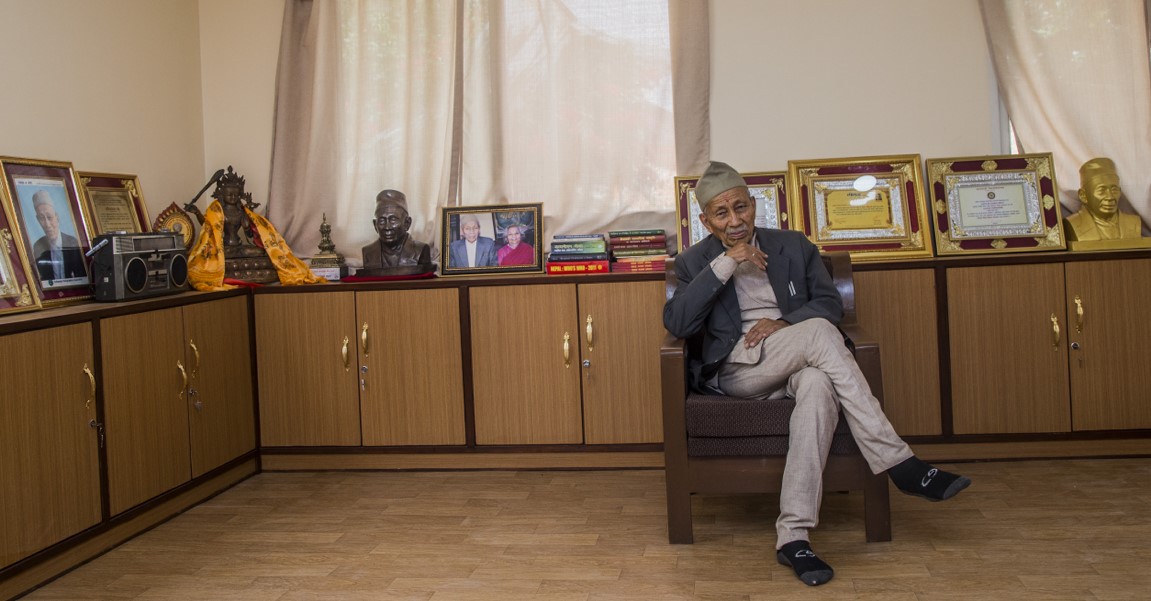
Some donors have constructed a small shed-like edifice next to his house, it looked nice and new, and some work was being finished. It is apparently to house his collection of books, magazines, manuscripts, et all; a library. Some students had also given time to arrange all these and other knick knack and packed them in aluminum trunks. So, soon they will be arranged neatly on shelves in the new edifice. Looking at all this, I am certain that the entire premises will one day in the future be a historical monument that will attract many visitors.
Having absorbed as much as I could, I got on my bike and roared off, but right round the first corner of the narrow alley, I stopped. A bookshop displayed the latest issue of ECS Nepal, along with other periodicals. I requested the lady minding the shop if I could take it to present it to Satya Mohan Joshi. I explained about our plans. She was very happy, I could see, on hearing what I had to say, and willingly gave me the magazine. Not only that, she even began eulogizing about her esteemed neighbor to me. “He may be one hundred years, but he is still very sharp,” she said with a smile. “He often comes here to pick up newspapers and magazines, and although he now has a guard provided by the municipality, he insists on coming himself, saying, ‘I don’t want to bother anybody.’”
“Once, he saw some new magazines that interested him. He took out all the money he had, and seeing that he didn’t have enough, murmured, “Now, what to do?’ I told him that he could pay later, no problem, but he said that he wouldn’t like to do so. He is that kind of man,” she added.
This small exchange sowed some doubt in my mind; had the eminent academician been toying with me? Asking me what ECS stood for, and all that. Anyway, I went back to his home and handed over the magazine; he was again rummaging around in the store room with the mask back on his face.
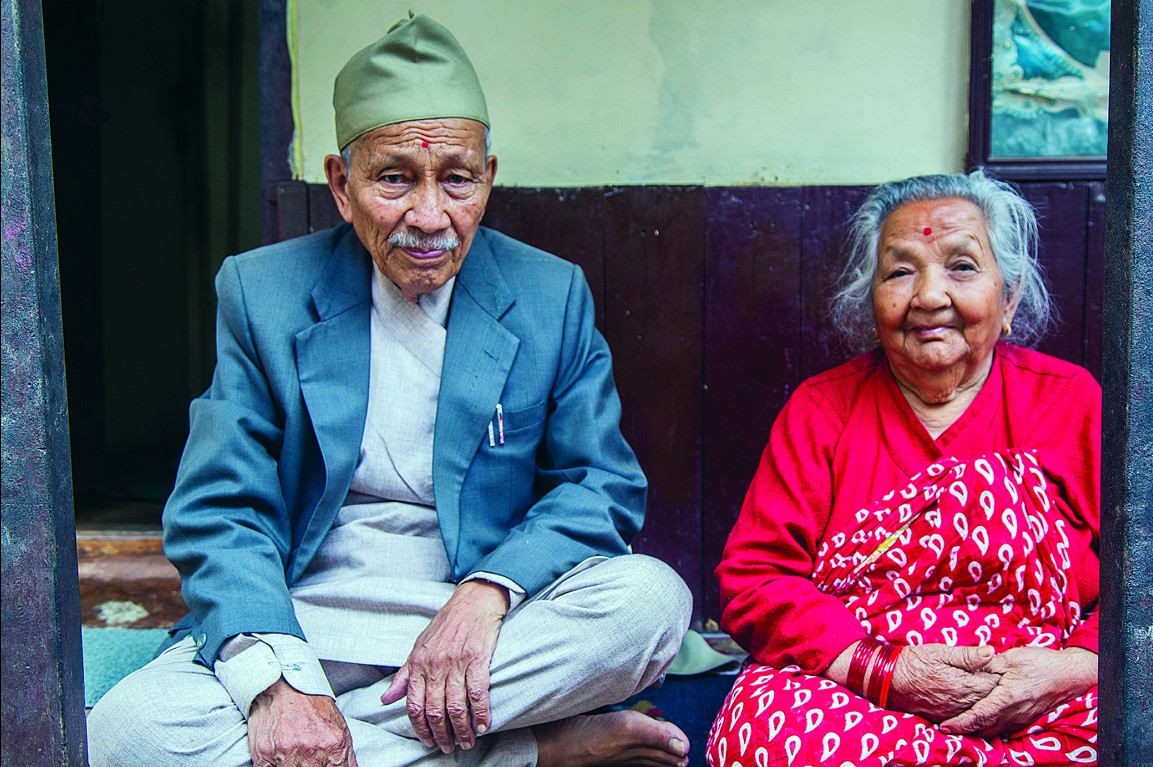
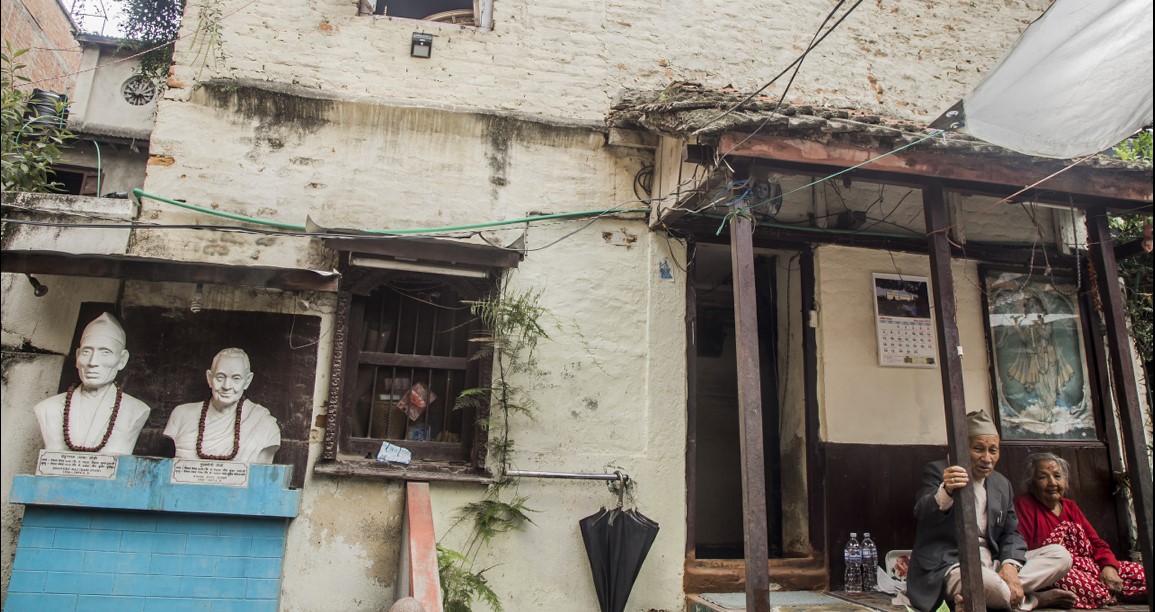
A Century of Accomplishments
Now, this is where I say something about his achievements, but before that, let me inform that even at the ripe age of one hundred years, he has a substantial looking manuscript ready for publication. This is what I discovered during my previous visit a month or so ago. It’s not on just any other subject, let me tell you; it’s a book about Newari idioms, their origins, their meanings, and so on, and it’s not just a few hundred idioms we’re talking about, but hundreds and hundreds more than that. He had disclosed to me then about looking for a sponsor to have it published, and he had stated his preference for a hard bound copy.
Well, that’s what’s on his plate right now. About the years gone by, he is generally acknowledged as the foremost expert on Nepali culture, including history, art, language, folklore, folk songs, and lifestyle. He is the Founder-Member (later Chancellor) of Nepal Bhasa Academy, which is located in Kirtipur. Its aim is the preservation and upliftment of the Newar language (Nepal Bhasa). He is also Founder-Curator of Arniko White Dagoba Gallery, located in the same building. The academy is a special high point in a life full of accomplishments, and it was possible because of his high standing that attracted many donors to contribute generously. The gallery, on the other hand, was a result of his five-year stay in China, and the resultant collection of numerous artifacts related to Arniko, the Nepali architect/artist of Patan who earned name, fame, and riches in China in the thirteenth century.
Besides the academy, his other great contribution is the production of a dictionary on the Nepal Bhasa, and thirteen more in the country’s other regional languages. In 1959, he was appointed the first director of the Archeological and Cultural Department. He was responsible for the establishment the Rastriya Naachghar (National Theater) in Kathmandu, the National Painting Museum in Bhaktapur, the Archeological Garden in Patan, and the Archeological Museum in Taulihawa. After resigning from service the next year, he went to China, and lived there for about five years as a Nepali language teacher at the Peking Broadcasting Institute. He was appointed a member of the Royal Nepal Academy from 1969 to 1978, and was its Member Secretary when he left.
He is also a renowned playwright, and he has a special affinity towards folk songs, admitting that folk culture is his primary subject of study. He also reveals that his career actually started by collecting folk songs, which he did by visiting numerous villages all over the country. His collection was published as Hamro Lok Sanskrit’ (Our Folk Culture) in 1956, and it went on to win the Madan Puraskar, the nation’s highest literary honor.
In 1957, he published Nepali Rastriya Mudra (Coinage of Nepal), and this, too, won the prestigious award, as did his 1971 work, Karnali Lok Sanskriti (Folk Culture of Karnali). His Jayaprakash, an epic in Nepali Bhasa, won him the Shrestha Sirpa award. His other publications also include Legends of Lalitpur and Kalakar Arniko. His vast knowledge has often been called for in issues of national importance, such as when designing new commemorative coins and stamps, and he was once (perhaps still is) on the Central Bank’s committee for designing new coins.
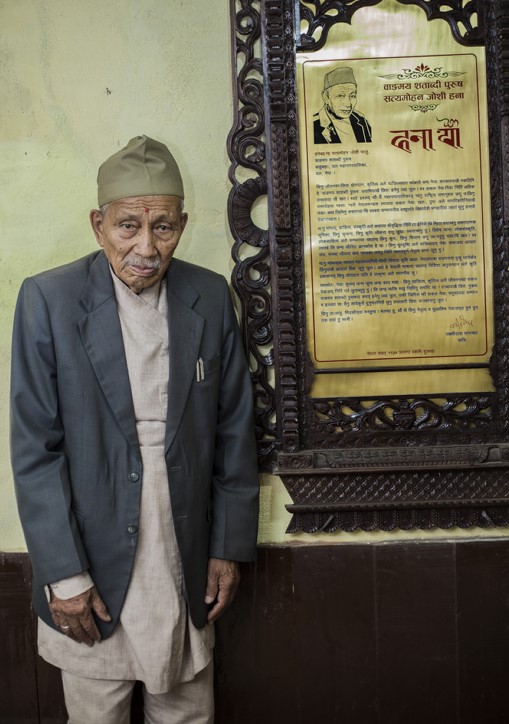
The Day We Took Photographs
I fixed a day to take his photographs, and went to his home. His wife, Radha Devi, was on the porch. She’s a nice lady with a ready smile always on her pleasant face. She told us that her husband was just finishing his lunch. She also disclosed that he would be going somewhere around two in the afternoon for some function. Mr. Joshi greeted us and said he would get ready. We waited quite a while; it was a credit to us that he took some time in getting ready. In the meantime I asked his wife about their family. “We have three sons and three daughters,” she said, “and twelve grandchildren and seven great grandchildren.” She disclosed that she was fourteen, and he nineteen, when they got married some eighty or so years ago.
Her husband came out dressed in a dark grey dauara suruwal and coat. He had his familiar black Nepali topi on his head, and also had put on a small red tika on his wide forehead. We went into the new construction besides the house. “This was handed over yesterday,” he said. “It was built by an organization called The Art Village.” The large room had a double bed (presumably to take a rest during the day), a couple of sofa sets, and a long L-shaped cabinet along one wall, on which sat the old tape record-cum-radio, a dozen literary books, half a dozen or so framed awards, and two busts of the centenarian, one golden, the other bronzed.
“Among the hundreds of awards you have received, which one do you value the most,” I asked. His replied without hesitation, “The one presented by Trimurti Niketan honoring me as the ‘Satabdi Purush’ (Man of the Century).” The bronze plaque that hangs on the wall in the dark prayer room is as tall as the man himself. It is signed by many heavyweights of the literary and political world, and it was presented during the ‘Satya Mohan Joshi Centenary Festival’ observed in his singular honor.
We also take photographs in the adjoining garden, where there is a small shrine with a granite plaque with embossed figures of Mayadevi and Siddartha Gautam at the time of his miraculous birth. Over it is a young pipal bot (pipal tree), its large oval leaves looking fresh and new. “It gives oxygen, you know,” he says. But, he actually is more eager to tell me the story behind this particular tree. “There was once a pipal bot (a.k.a. the Bodhi Briksha, under one of which Buddha attained enlightenment) at the Maya Devi Temple in Lumbini,” he began. “For some reason, and mostly due to ignorance, it was cut down. UNESCO was furious, since Lumbini is a World Heritage Site, and wanted to know why the Department of Architecture had not prevented it from happening. Anyway, IUCN stepped in and sent the remnant of the tree for tissue culturing. From the saplings so recovered, I received two. This is one, and the other I have planted at the Nepal Bhasa Academy in Kirtipur.”
Not wanting to tire him, it being a hot and humid day, and he being a hundred and all, we finished with the photography. But, before bidding goodbye, I asked him about his schedule for the day. “Well, there’s one in Bhatbhateni, where I have been asked to be the chief guest and award literary prizes instituted by a couple from Bandipur in their parents’ memory. Then, after that, I have been asked to bestow my blessings and inaugurate a new drama performance in another place,” he replied with a rueful smile. It’s close to a grimace, but of course he is too nice for that, but surely, he must be a bit tired from having to attend such functions throughout the month at one program or the other. And, at his age! However, let me emphasize again, he’s too much the epitome of humility, simplicity, and magnanimity to say no when so requested.
One last time, we bid adieu, but he asks me to wait for a moment, and going inside the house, he comes out with yet another manuscript. This one has a photograph of him and the title, ‘Jureli Darshan’. “It will be published soon,” he says, and adds that it is about his life and an answer to the very frequent question he gets about the secret to his long and healthy life. “What is the secret, in short?” I ask. And he says, “A life free from stress.” “And, how can we be free from stress?” I ask, and he answers with a saying that can perhaps be translated as, ‘All the goings-on in the forest is of no concern to the nightingale; it will continue to sing its beautiful songs.’









